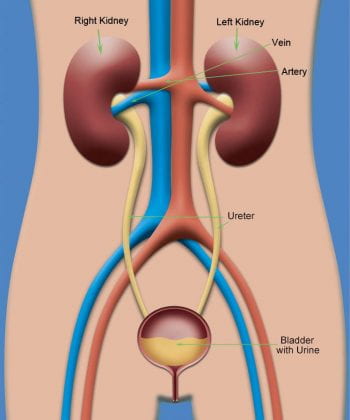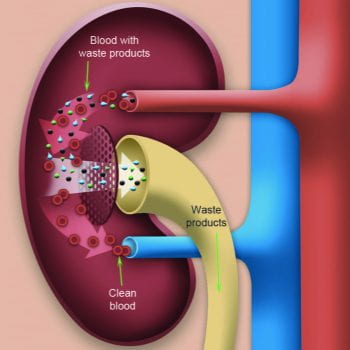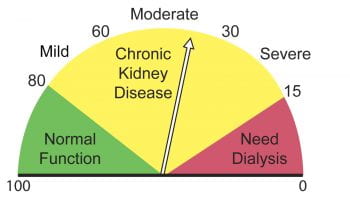About your kidneys
What and where are the kidneys?
The kidneys are twin organs shaped like kidney beans. They are located in the middle of your back below the ribs. In adults, each kidney is about the size of a closed fist and weighs about 3 pounds. A small number of people have only one kidney but lead completely normal lives.

Kidneys connect to the blood supply with an artery and a vein. They are also connected to the bladder by a tube called a ureter. The ureter carries the urine from the kidneys to the bladder and then out of the body. The kidneys are made up of a million tiny working units called nephrons. The number of nephrons is different for each person and that number is determined at birth. The body cannot make new nephrons if they are damaged. The kidneys contain approximately 8 miles of small blood vessels that form tiny filters; 200 quarts of blood are filtered and purified each day (about 3 tablespoons a minute).
What do the kidneys do?
Your body eliminates about two quarts of waste products, salt and excess fluid each day, in the form of urine. These waste products come from the breakdown of food you eat and the byproducts of normal muscle activity.

In addition to removing wastes and fluid from your body your kidneys also:
- Balance important minerals and chemicals in your body, such as sodium, potassium, phosphorus and calcium
- Remove drugs and toxins introduced into your body
- Produce hormones that help control your blood pressure, make red blood cells and help keep bones strong
As we get older, the tiny filters of the kidney suffer damage and scarring as part of normal aging. However, our body needs only about half of the normal kidney function to remain completely healthy.
Symptoms from low kidney function rarely occur until the function is less than 30%. Dialysis or kidney transplant is not needed until kidney function is less than 10 to 15%.
What is kidney disease?
Anyone can have kidney disease. In fact, two U.S. presidents had kidney disease while in office. Kidney disease affects people of all ages and races. More than 26 million Americans – one in nine adults – have some form of kidney disease.
There are many reasons why kidneys become damaged, but the two most common causes are the effects of diabetes and high blood pressure. There are also inherited kidney diseases, such as polycystic kidney disease, which can lead to kidney damage.
The main function of the kidney is to filter our blood. Like any filter, the kidney gets less efficient the longer it is used. Scars in the tissues form in the kidney as part of normal aging but are made worse when certain diseases, like hypertension or diabetes, put more strain on the kidney. The kidneys do not regenerate, so to prepare for this normal loss, the kidney is designed to function even to 50% loss.

Symptoms from low kidney function rarely occur until the function is less than 30%. This is where intervention is necessary to slow the progression of the disease known as chronic kidney disease (CKD). Damaged kidneys cannot perform their normal functions of removing wastes and toxins from the body. This buildup of toxins and wastes affects the whole body.
Dialysis or kidney transplant is not needed until kidney function is less than 10 to 15%.